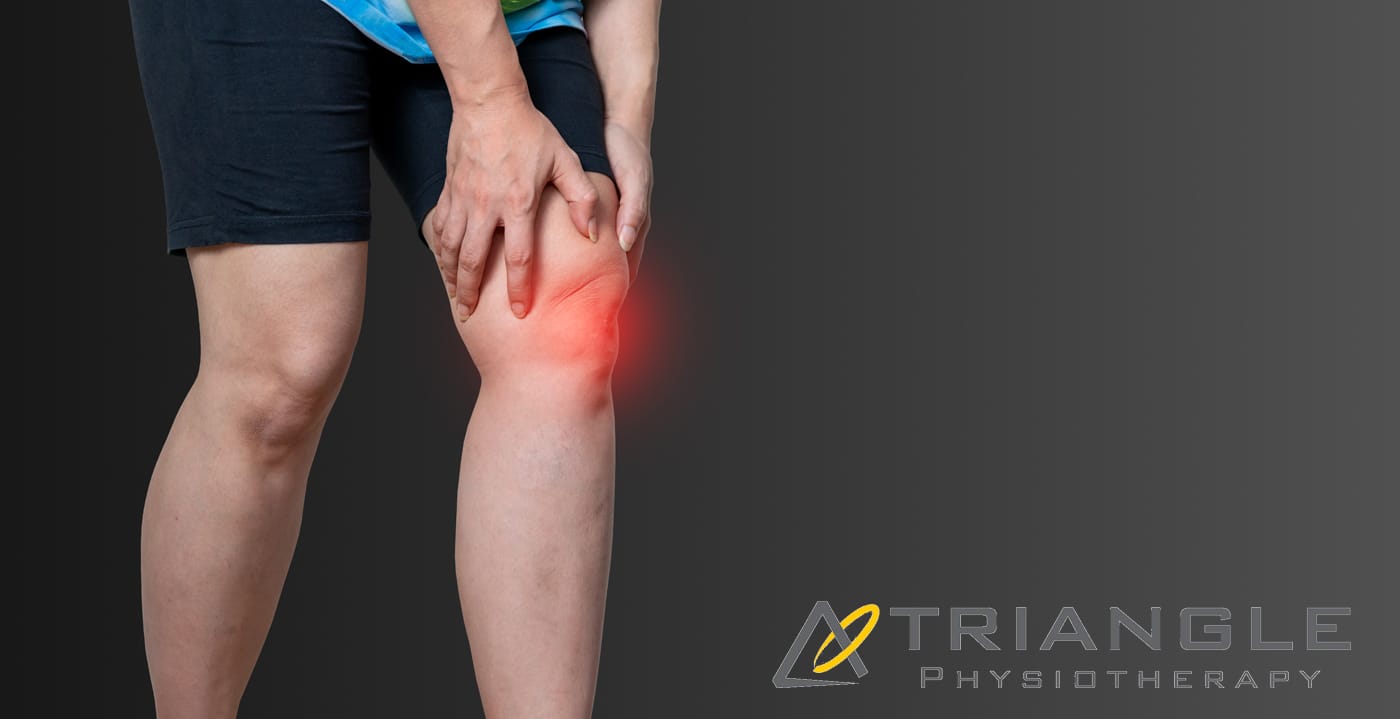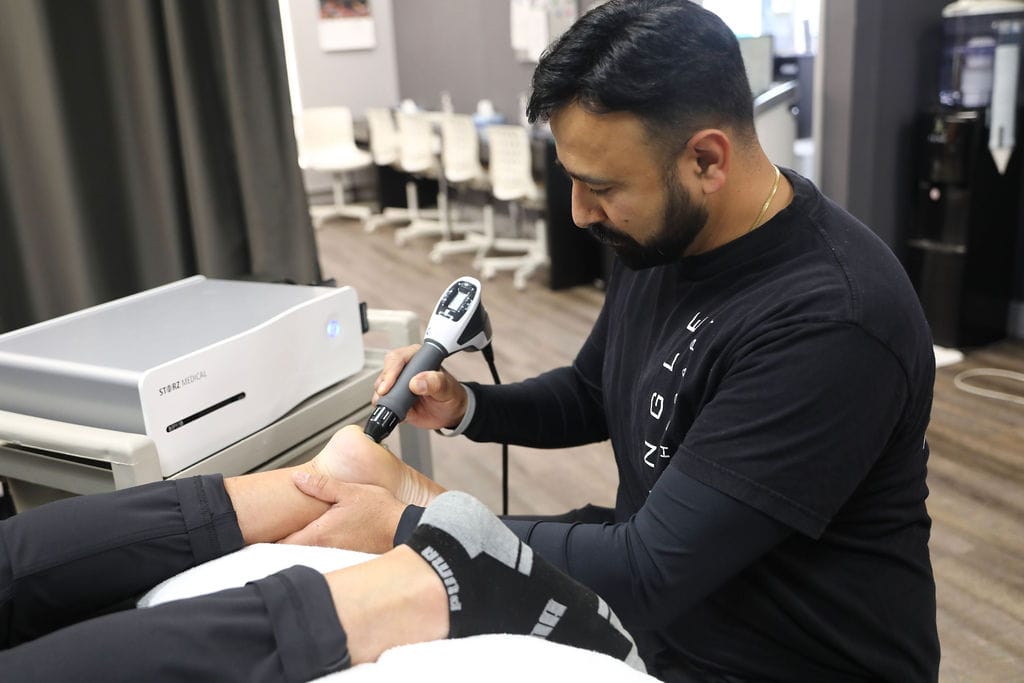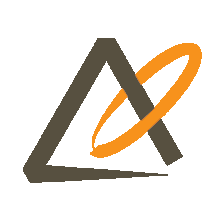A stiff neck refers to a condition where the muscles in the neck feel tight, sore, and difficult to move.
What are the causes of a stiff neck?
A Stiff Neck can be caused by various factors, including muscle strain, tension, or injury. Some common causes of a stiff neck include:
- Muscle Strain: Overuse or sudden movements that strain the neck muscles can lead to stiffness.
- Poor Posture: Maintaining an improper posture, especially for extended periods, can contribute to neck stiffness.
- Sleeping Position: Sleeping in an awkward or uncomfortable position, or using a pillow that doesn’t support the neck properly, may result in stiffness.
- Neck Injury: Accidents or injuries, such as whiplash from a car accident, can cause neck stiffness.
- Stress and Tension: Emotional stress and tension can contribute to muscle tension and stiffness in the neck.
- Text Neck: Spending extended periods looking down at electronic devices, such as smartphones or tablets, can strain the neck and lead to stiffness.
- Underlying Medical Conditions: Certain medical conditions, such as arthritis, cervical spine disorders, or infections, can also cause a stiff neck.
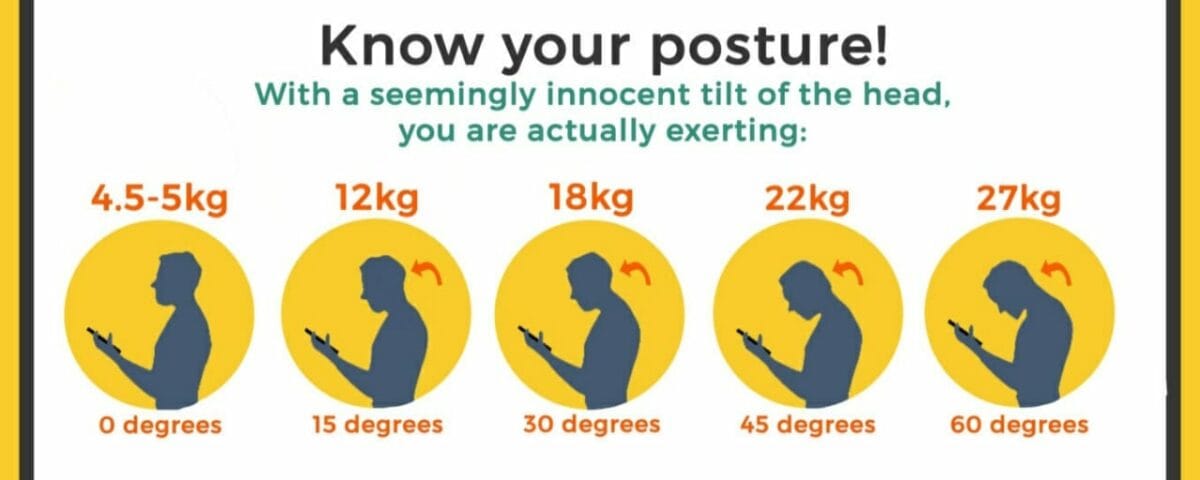
How do I fix a stiff neck?
Do not despair, there are many ways to help resolve a stiff neck.
- Stretch – Visit a physiotherapist or chiropractor and they can show you the best stretches for a stiff neck.
- Massage Therapy – Book an appointment with a registered massage therapist who can help release the knots and help with relaxing the tight muscles.
- Use a heating pad to get some relief from the pain. A hot shower helps as well.
- Manual Therapy – See a physiotherapist who can use manual therapy techniques to release and mobilize the joint.
- Dry-needling – A physiotherapist who does dry-needling can make a difference in resolving your stiff neck.
- Sleeping Position – Your physiotherapist can educate you on modifying your sleeping position so that your stiff neck does not become a recurring problem.
How do I book an appointment with a Physiotherapist near me?
Click HERE to book an appointment with a physiotherapist or chiropractor at one of our eight locations.
- Physiotherapy Etobicoke – Triangle Physiotherapy Etobicoke
- Oakville Physiotherapy Clinic – Triangle Physiotherapy Oakville
- Physiotherapy North York – Triangle Physiotherapy North York
- Mississauga Physiotherapy Clinics – Triangle Physiotherapy Mississauga
- Downtown Physiotherapy Clinics – Triangle Physiotherapy King West
- Uptown Physiotherapy Clinics – Triangle Physiotherapy Lawrence Park
- Physiotherapy Clinic Downtown Toronto – Triangle Physiotherapy Queens Quay
- Physiotherapy Clinics Mississauga – Triangle Physiotherapy Erin Mills
“Dealing with a stiff neck can be painful and frustrating, but with the right physiotherapy, relief is possible. Triangle Physiotherapy offers expert care across the GTA, including Physiotherapy in Etobicoke, Oakville, North York, Toronto, Lawrence Park, Queens Quay, Erin Mills, Mississauga, and Liberty Village. Our skilled therapists are here to help you alleviate neck stiffness and improve your mobility.”
Sleep plays a crucial role in promoting overall health and well-being. It is a fundamental physiological process that is essential for various functions in the body.
Healthy bedtime habits can make a big difference in your quality of life. Having healthy sleep
habits is often referred to as having good “sleep hygiene.”
Why is sleep important?
Sleep is critical to many of our body systems, including:
- Optimal immune function
- Tissue healing
- Cardiovascular health
- Cognitive function, learning, and memory.
What are the effects of inadequate sleep?

The effects of not sleeping well are:
- Increased pain perception
- Reduced quality of life
- Loss of optimal function
- Anxiety and depression
- Lack of attention
- Impaired memory
- Increased risk of accidents, falls, and other injuries
- Some studies have also indicated sleep disorders may be a risk factor for cancer.
What is Sleep Hygiene?
Having healthy sleep habits is also known as having good “Sleep Hygiene”. Here are some tips on creating good sleep hygiene:
- Try to stick to a sleeping schedule – have a consistent bedtime and wake-up time.
- Have a bedtime ritual that involves a relaxing routine like a skincare routine, listening to relaxing music, or reading a few pages of a book.
- Avoid being on electronics closer to bedtime.
- Exercise every day.
- Avoid naps during the day.
- Ensure your mattress and pillows are comfortable.
- Avoid eating heavy meals 2-3 hours before bedtime. Avoiding alcohol, caffeine, and cigarettes also helps.
- Evaluate your room, eliminate bright lights, and make sure the temperature is set to your comfort level.
- If your partner snores, get a pair of earplugs. If a window has a sliver of bright light that bothers you, consider getting a sleep mask.
What does physiotherapy have to do with sleep?
Physiotherapists are advocates for prevention and health promotion. They have a wealth of information to educate their patients on living a healthy lifestyle and improving their quality of life. Physiotherapists can also help with:
- Pain Management: Individuals with chronic pain conditions, such as back pain, neck pain, or joint pain, may experience difficulty sleeping. Physiotherapy interventions, such as exercises, stretches, and manual therapy, can help manage and alleviate pain, promoting better sleep.
- Posture and Alignment: Poor posture or musculoskeletal misalignments can contribute to discomfort during sleep. Physiotherapists can assess and address postural issues, providing exercises and interventions to improve alignment and reduce pain, potentially enhancing sleep quality.
- Muscle Tension and Relaxation: Physiotherapy techniques, such as massage, stretching, and relaxation exercises, can help reduce muscle tension. Individuals who experience muscle stiffness or tension-related sleep disturbances may benefit from physiotherapy interventions aimed at promoting relaxation.
- Respiratory Function: Some physiotherapy techniques focus on respiratory function and breathing exercises. Improving respiratory function can contribute to better oxygenation and may have positive effects on sleep quality, especially for individuals with conditions like sleep apnea.
- Exercise and Physical Activity: Regular physical activity, prescribed and guided by a physiotherapist, has been linked to improved sleep. Exercise can contribute to overall well-being, reduce stress, and enhance sleep duration and quality.
- Sleep Posture and Ergonomics: Physiotherapists can guideon proper sleep posture and ergonomic considerations. This may include recommendations for pillows, mattresses, and sleep positions that support musculoskeletal health and minimize discomfort.
- Stress Reduction: Physiotherapy interventions often include stress management techniques. Stress and anxiety can negatively impact sleep, so addressing these factors through physiotherapy may indirectly contribute to improved sleep.
How do I book an appointment with a Physiotherapist near me?
Click HERE to book an appointment with a physiotherapist or chiropractor at one of our eight locations.
- Physiotherapy Etobicoke – Triangle Physiotherapy Etobicoke
- Oakville Physiotherapy Clinic – Triangle Physiotherapy Oakville
- Physiotherapy North York – Triangle Physiotherapy North York
- Mississauga Physiotherapy Clinics – Triangle Physiotherapy Mississauga
- Downtown Physiotherapy Clinics – Triangle Physiotherapy King West
- Uptown Physiotherapy Clinics – Triangle Physiotherapy Lawrence Park
- Physiotherapy Clinic Downtown Toronto – Triangle Physiotherapy Queens Quay
- Physiotherapy Clinics Mississauga – Triangle Physiotherapy Erin Mills
“Good sleep is essential for overall well-being, and addressing physical discomfort can significantly improve sleep quality. Triangle Physiotherapy offers expert services across the GTA, including Physiotherapy in Etobicoke, Oakville, North York, Toronto, Lawrence Park, Queens Quay, Erin Mills, Mississauga, and Liberty Village. Our skilled physiotherapists can help you manage pain and improve your sleep, contributing to better overall health.”
Carpal tunnel syndrome is a painful disorder of the hand caused by the entrapment of the median nerve that passes through the carpal tunnel at the wrist. The wrist bones (carpal bones) form the base of the tunnel and strong ligaments (flexor retinaculum) form the roof. The carpal tunnel contains the median nerve, blood vessels, and tendons that pass to and from your hand. Carpal tunnel syndrome occurs when either the space in the tunnel decreases or when the contents enlarge.
What are the causes of carpal tunnel syndrome?
Some common causes and risk factors include:
- Repetitive hand and wrist movements: Performing repetitive motions with the hands and wrists, especially in awkward positions, can contribute to the compression of the median nerve. This is common in activities such as typing, using a computer mouse, or assembly line work.
- Prolonged wrist flexion: Keeping the wrist in a flexed or extended position for extended periods can increase pressure on the median nerve. This can happen during activities like using a computer keyboard or mouse, playing musical instruments, or using tools that vibrate.
- Anatomical factors: Certain anatomical characteristics, such as having a smaller carpal tunnel or a shape that predisposes to compression, can increase the likelihood of developing carpal tunnel syndrome.
- Trauma or injury: A wrist injury or trauma, such as a fracture or sprain, can lead to swelling and inflammation in the carpal tunnel, compressing the median nerve.
- Medical conditions: Certain medical conditions, such as rheumatoid arthritis, diabetes, and thyroid disorders, can increase the risk of carpal tunnel syndrome. Hormonal changes, such as those that occur during pregnancy or menopause, can also contribute.
- Genetics: There may be a genetic predisposition to carpal tunnel syndrome, as some individuals may have a family history of the condition.
- Obesity: Being overweight or obese may increase the risk of developing carpal tunnel syndrome, possibly due to increased pressure on the median nerve.
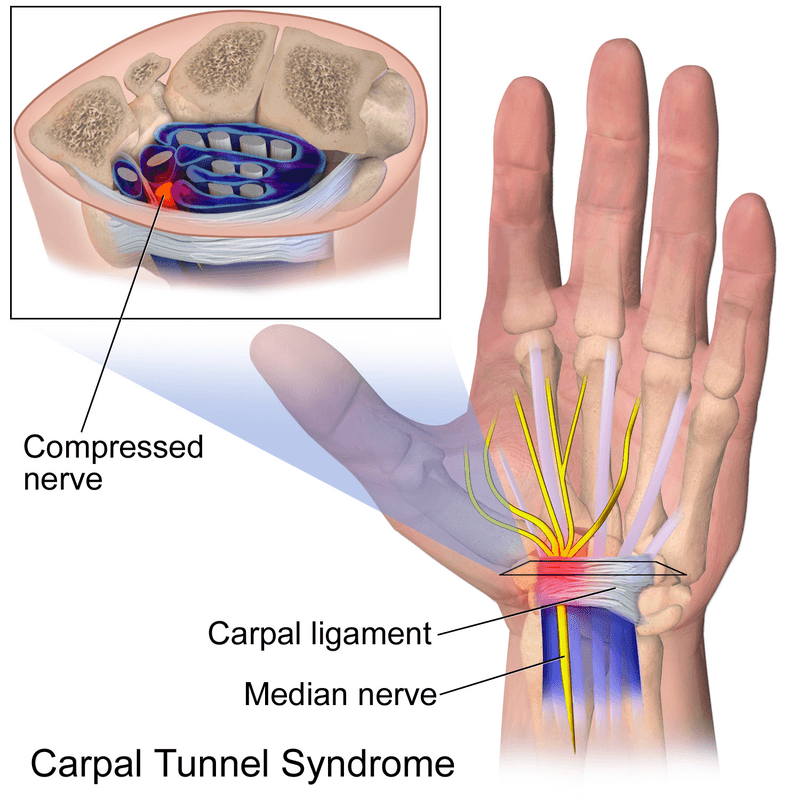
Who is most at risk for carpal tunnel syndrome?
Women are more commonly affected by carpal tunnel syndrome than men, possibly due to differences in hand anatomy and hormonal factors.
CTS is more prevalent in individuals who are middle-aged or older. As people age, the risk of developing the condition increases.
What are the symptoms of carpal tunnel syndrome?
- Gradual onset of pain, burning, tingling, or numbness in the median nerve pathway (the thumb, index finger, and middle finger)
- Symptoms may be worse at night or early in the morning
- Symptoms may be relieved by shaking or flicking of the hand
- As the condition progresses, there may be numbness, weakness, and muscle wasting of the thumb muscles causing difficulty with pinching, gripping, and frequently dropping things
Can physiotherapy help with Carpal Tunnel Syndrome?
Physiotherapy treatment for carpal tunnel syndrome:
- Education on rest, activity modification, and workplace ergonomics
- Mobilization of the carpal bones and the median nerve
- Therapeutic ultrasound therapy over the carpal tunnel to speed up healing
- Splinting the wrist during sleep
- Exercises to stretch and strengthen forearm and hand muscles, nerve gliding and correction exercises
- Acupuncture
How do I book an appointment with a Physiotherapist near me?
Click HERE to book an appointment with a physiotherapist or chiropractor at one of our eight locations.
- Physiotherapy Etobicoke – Triangle Physiotherapy Etobicoke
- Oakville Physiotherapy Clinic – Triangle Physiotherapy Oakville
- Physiotherapy North York – Triangle Physiotherapy North York
- Mississauga Physiotherapy Clinics – Triangle Physiotherapy Mississauga
- Downtown Physiotherapy Clinics – Triangle Physiotherapy King West
- Uptown Physiotherapy Clinics – Triangle Physiotherapy Lawrence Park
- Physiotherapy Clinic Downtown Toronto – Triangle Physiotherapy Queens Quay
- Physiotherapy Clinics Mississauga – Triangle Physiotherapy Erin Mills
“Managing Carpal Tunnel Syndrome effectively can improve your quality of life, and Triangle Physiotherapy is here to help. We offer expert services across the GTA, including Physiotherapy in Etobicoke, Oakville, North York, Toronto, Lawrence Park, Queens Quay, Erin Mills, Mississauga, and Liberty Village. Our skilled physiotherapists can provide tailored treatment plans to alleviate symptoms and restore function in your hands and wrists.”
What is the ACL?
The ACL, or Anterior Cruciate Ligament, is one of the four major ligaments in the knee joint. It is located in the center of the knee and runs diagonally, connecting the femur (thigh bone) to the tibia (shin bone). Its primary function is to prevent excessive forward movement of the tibia relative to the femur and control rotational movements of the knee.
What is an ACL Injury?
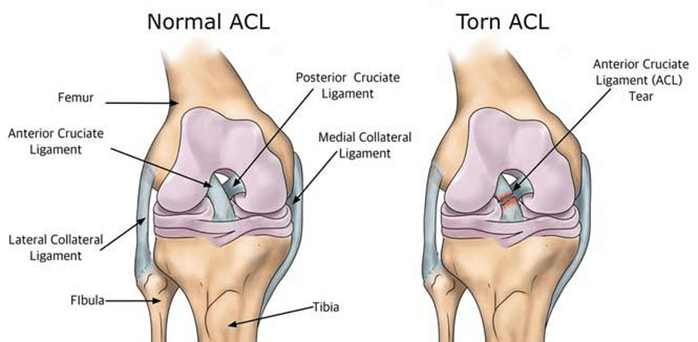
Injuries to the ACL are relatively common, often occurring during sports activities that involve sudden stops, changes in direction, or direct impact on the knee. ACL injuries can range from mild sprains to complete tears. When the ACL is torn, it can lead to instability in the knee, difficulty with weight-bearing, and a decreased ability to perform certain activities.
Consulting with a physiotherapist at Physiotherapy Oakville is crucial for recovery, as scientific research has shown that structured physiotherapy programs significantly improve outcomes for ACL injuries. These programs focus on strengthening the muscles around the knee, improving flexibility, and restoring stability. By joining Physiotherapy Oakville, you can benefit from evidence-based treatments and personalized exercise plans that enhance your recovery process, reduce the risk of further injury, and help you return to your normal activities with confidence.
What are the symptoms of an ACL injury?
Common symptoms of an ACL injury include:
- Pain: Individuals with an ACL injury often experience pain in the knee. The intensity of the pain can vary based on the severity of the injury.
- Swelling: Swelling typically occurs within a few hours of the injury and may be accompanied by a feeling of tightness or fullness in the knee.
- Instability: A sense of instability or a feeling that the knee is “giving way” is a common symptom. This instability may be particularly noticeable during activities that involve cutting, pivoting, or sudden changes in direction.
- Loss of Range of Motion: The injured knee may have a reduced range of motion, and it may be challenging to fully straighten or bend the knee.
- Audible “Pop” Sound: Some people report hearing or feeling a “pop” at the time of the injury. However, not everyone experiences this sensation.
- Difficulty Weight-bearing: Walking or putting weight on the affected leg may be difficult, especially immediately after the injury.
Can Physiotherapy help with an ACL Injury?
Yes, physiotherapy is a crucial component of the rehabilitation process for individuals with an ACL (Anterior Cruciate Ligament) injury, particularly those who undergo surgical intervention such as ACL reconstruction. Physiotherapy aims to address pain, swelling, muscle weakness, and joint instability while helping individuals regain normal function and return to their usual activities.
Here are some ways in which physiotherapy can help with an ACL injury:
- Post-operative Rehabilitation: After ACL reconstruction surgery, physiotherapy plays a vital role in the postoperative rehabilitation process. The early phases focus on managing pain and swelling, restoring range of motion, and preventing muscle atrophy.
- Strengthening Exercises: Physiotherapists prescribe specific exercises to strengthen the muscles around the knee, including the quadriceps, hamstrings, and calf muscles. Strengthening these muscles helps provide stability to the knee joint.
- Balance and Proprioception Training: ACL injuries can affect balance and proprioception (awareness of joint position). Physiotherapy incorporates exercises to improve balance and proprioception, reducing the risk of future injuries and enhancing overall joint stability.
- Range of Motion Exercises: Physiotherapists guide patients through a series of exercises to regain and maintain a normal range of motion in the knee. This is important for preventing stiffness and improving functional mobility.
- Functional Training: As the rehabilitation progresses, physiotherapy includes functional activities and sport-specific exercises to help individuals return to their normal activities or sports safely.
- Education and Home Exercise Programs: Physiotherapists educate patients about their condition, recovery process, and strategies for preventing future injuries. They often provide home exercise programs to continue rehabilitation between sessions.
- Gradual Return to Sports: For individuals aiming to return to sports or high-demand activities, physiotherapy guides a gradual progression of exercises to ensure a safe and effective return, taking into account factors like strength, agility, and neuromuscular control.
Our More Locations
Physiotherapy Etobicoke | Physiotherapy Oakville | Physiotherapy North York | Physiotherapy Toronto | Physiotherapy Lawrence Park | Physiotherapy Mississauga | Physiotherapy Queens Quay | Physiotherapy Mississauga Erin Mills | Physiotherapy Liberty Village
How do I book an appointment with a Physiotherapist near me?
Click HERE to book an appointment with a physiotherapist or chiropractor at one of our eight locations.
- Physiotherapy Etobicoke – Triangle Physiotherapy Etobicoke
- Oakville Physiotherapy Clinic – Triangle Physiotherapy Oakville
- Physiotherapy North York – Triangle Physiotherapy North York
- Mississauga Physiotherapy Clinics – Triangle Physiotherapy Mississauga
- Downtown Physiotherapy Clinics – Triangle Physiotherapy King West
- Uptown Physiotherapy Clinics – Triangle Physiotherapy Lawrence Park
- Physiotherapy Clinic Downtown Toronto – Triangle Physiotherapy Queens Quay
- Physiotherapy Clinics Mississauga – Triangle Physiotherapy Erin Mills
“Starting physiotherapy at the right time after ACL surgery is crucial for optimal recovery. Triangle Physiotherapy offers expert care across the GTA, including Physiotherapy in Etobicoke, Oakville, North York, Toronto, Lawrence Park, Queens Quay, Erin Mills, Mississauga, and Liberty Village. Our experienced physiotherapists can guide you through a personalized rehabilitation program to help you regain strength and mobility efficiently.”
What is Plantar Fasciitis?
Plantar fasciitis is an overuse injury. Accumulation of micro-damage leads to the degradation of the collagen fibers that make up the origin point of the plantar aponeurosis. This prevalent condition is the most common cause of heel pain. It is a common condition characterized by inflammation of the plantar fascia, a thick band of tissue that runs along the bottom of your foot. Managing plantar fasciitis involves a combination of lifestyle changes, exercises, and medical interventions.

What are the risk factors for plantar fasciitis?
- Overpronation
- High-Arched Feet
- Leg-length Discrepancy
- Footwear
Here are five ways to manage plantar fasciitis:
- Stretching Exercises:
- Perform gentle stretching exercises for the Achilles tendon, calf muscles, and plantar fascia. Regular stretching can help alleviate tension and improve flexibility.
- Towel stretches, calf stretches, and wall stretches are beneficial for targeting the affected areas.
2. Night Splints:
- Wear night splints to keep the foot in a dorsiflexed position while sleeping. This helps stretch the plantar fascia and Achilles tendon, promoting healing and reducing morning pain.
3. Custom Orthotics
- For orthotics to successfully treat plantar fasciitis, they need to control overpronation and the motion of the first metatarsal head.
4. Supportive Footwear
- Choose shoes with proper arch support and cushioning to reduce strain on the plantar fascia. Avoid high heels and worn-out shoes.
- Consider orthotic inserts or custom-made insoles to provide additional support and stability.
5. Physiotherapy
- Consult with a physiotherapist who can guide you through exercises and techniques to strengthen the muscles around the foot and improve overall foot mechanics.
- Shockwave therapy has been known to show great results in the management of plantar fasciitis.
How do I book an appointment with a Physiotherapist near me?
Click HERE to book an appointment with a physiotherapist or chiropractor at one of our eight locations.
- Physiotherapy Etobicoke – Triangle Physiotherapy Etobicoke
- Oakville Physiotherapy Clinic – Triangle Physiotherapy Oakville
- Physiotherapy North York – Triangle Physiotherapy North York
- Mississauga Physiotherapy Clinics – Triangle Physiotherapy Mississauga
- Downtown Physiotherapy Clinics – Triangle Physiotherapy King West
- Uptown Physiotherapy Clinics – Triangle Physiotherapy Lawrence Park
- Physiotherapy Clinic Downtown Toronto – Triangle Physiotherapy Queens Quay
- Physiotherapy Clinics Mississauga – Triangle Physiotherapy Erin Mills
Managing plantar fasciitis effectively requires a combination of the right treatments and exercises. For professional support in addressing foot pain, consider physiotherapy in Etobicoke, Oakville, North York, Toronto, Lawrence Park, Queens Quay, Erin Mills, Mississauga, or Liberty Village. Experienced physiotherapists in these areas can provide personalized care plans to help you recover and stay active.
Physiotherapy can certainly help with posture issues. Have you caught yourself slouching or seen a reflection of yourself in a window, shoulders hunched? If yes, you are not alone. The good news is that there are ways to improve your posture and health practitioners like physiotherapists and chiropractors can help.
Why does good posture matter?
Maintaining proper posture extends beyond merely standing upright; it entails positioning your body to reduce pressure and tension on your joints and muscles. This encompasses maintaining a straight spine, relaxed shoulders, a raised head in harmony with your body, and even hips, with knees directed forward. Good posture also involves ensuring that your chin is parallel to the floor and that your body weight is evenly distributed on both feet.
What are some common posture problems?
Some common posture problems are as below:
Forward Head Posture (FHP): This occurs when the head is positioned forward of the shoulders. It often results from prolonged periods of looking at screens or poor ergonomics.

Kyphosis (Round Shoulders): Kyphosis is an exaggerated rounding of the upper back. It can be caused by factors like slouching, muscle imbalances, or structural issues.
Lordosis (Swayback): Lordosis is an excessive inward curve of the lower back. It can be caused by factors such as poor sitting habits, weak core muscles, or pregnancy.
Flat Back Posture: This posture involves a reduction in the natural curve of the spine, particularly in the lower back. It may result from muscle imbalances or conditions like ankylosing spondylitis.
Scoliosis: Scoliosis is a lateral curvature of the spine, often appearing as an “S” or “C” shape. It can be congenital or develop during growth spurts in adolescence.
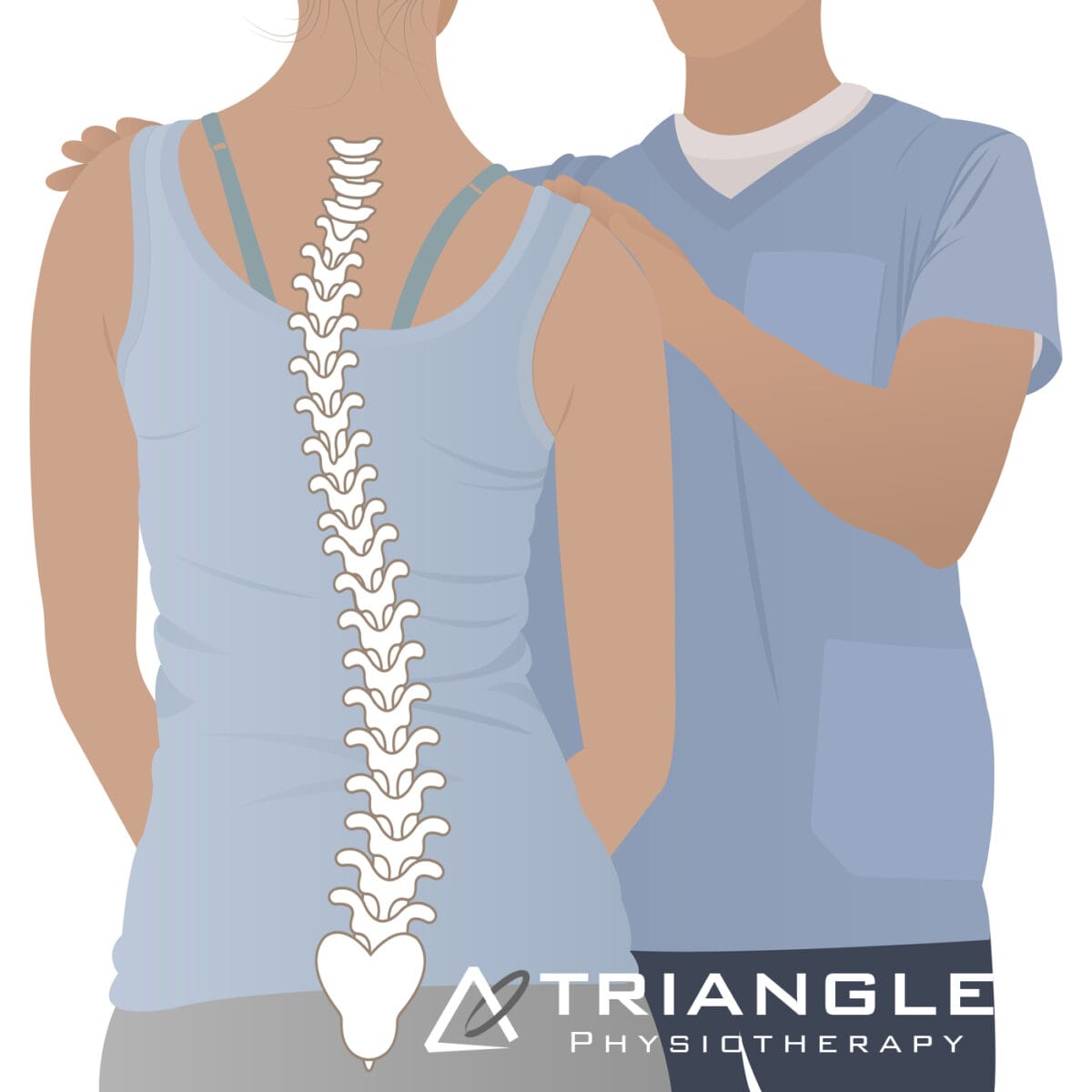
Rounded Shoulders: Rounded shoulders occur when the shoulders are pushed forward, and the chest collapses. This can be caused by muscle imbalances and poor habits like prolonged sitting.
Anterior Pelvic Tilt: This is when the front of the pelvis drops lower than the back, causing an exaggerated curve in the lower back. It can be caused by muscle imbalances, tight hip flexors, and weak abdominal muscles.
Posterior Pelvic Tilt: In this posture, the back of the pelvis drops lower than the front, flattening the lower back. It can be caused by weak hamstrings and glutes.
Crossed Syndrome: This is a pattern of muscle imbalances that can lead to poor posture. It typically involves a combination of tight and weak muscles, often seen in individuals with sedentary lifestyles.
Text Neck: This is a modern posture problem associated with the increased use of smartphones and devices. It involves a forward head position and increased strain on the neck and upper back.
How do I book an appointment with a Physiotherapist near me?
Click HERE to book an appointment with a physiotherapist or chiropractor at one of our eight locations.
- Physiotherapy Etobicoke – Triangle Physiotherapy Etobicoke
- Oakville Physiotherapy Clinic – Triangle Physiotherapy Oakville
- Physiotherapy North York – Triangle Physiotherapy North York
- Mississauga Physiotherapy Clinics – Triangle Physiotherapy Mississauga
- Downtown Physiotherapy Clinics – Triangle Physiotherapy King West
- Uptown Physiotherapy Clinics – Triangle Physiotherapy Lawrence Park
- Physiotherapy Clinic Downtown Toronto – Triangle Physiotherapy Queens Quay
- Physiotherapy Clinics Mississauga – Triangle Physiotherapy Erin Mills
“Improving your posture through physiotherapy can lead to better overall health and reduced pain. Triangle Physiotherapy offers expert services across the GTA, including Physiotherapy in Etobicoke, Oakville, North York, Toronto, Lawrence Park, Queens Quay, Erin Mills, Mississauga, and Liberty Village. Our skilled physiotherapists can help you develop a personalized plan to correct and maintain good posture.”
Winter weather can be challenging for individuals with arthritis, as cold temperatures and changes in atmospheric pressure can exacerbate joint pain and stiffness. Here are 10 tips to help manage arthritis during the winter months:
- Stay Warm:
- Start your day by using a heating pad or a warm bath or shower to increase the mobility in your joints and reduce pain before you go about your day.
- Dress in layers to trap heat and stay warm.
- Use heated blankets or warm packs on achy joints.
- Protect Your Joints:
- Wear gloves to keep your hands warm and protect your finger joints.
- Use knee-high socks and warm footwear to keep your feet and ankles insulated.
- Stay Active:
- Engage in gentle exercises to keep your joints flexible.
- Consider indoor activities like swimming, which is easy on the joints.
- Maintain a Healthy Weight:
- Excess weight can put more pressure on your joints, so try to maintain a healthy weight through a balanced diet and regular exercise.
- Stay Hydrated:
- Cold weather can lead to dehydration, which may worsen arthritis symptoms. Drink plenty of water to stay hydrated.
- Use Assistive Devices:
- Consider using assistive devices such as canes or braces to reduce the strain on affected joints.
- Manage Stress:
- Stress can exacerbate arthritis symptoms. Practice stress-reducing techniques like deep breathing, meditation, or yoga.
- Warm Up Before Activities:
- Before heading outdoors, warm up your body with gentle stretching exercises to prepare your joints for movement.
- Take Warm Baths:
- Soaking in a warm bath can help soothe joint pain and relax your muscles.
- Consult Your Doctor:
- Keep your healthcare provider informed about changes in your symptoms and discuss any concerns you have about managing arthritis in the winter.

Remember, it’s essential to tailor these tips to your specific situation, as arthritis can affect individuals differently. Always consult with your healthcare provider for personalized advice and treatment options.
How do I book an appointment with a Physiotherapist near me?
Click HERE to book an appointment with a physiotherapist or chiropractor at one of our eight locations.
- Physiotherapy Etobicoke – Triangle Physiotherapy Etobicoke
- Oakville Physiotherapy Clinic – Triangle Physiotherapy Oakville
- Physiotherapy North York – Triangle Physiotherapy North York
- Mississauga Physiotherapy Clinics – Triangle Physiotherapy Mississauga
- Downtown Physiotherapy Clinics – Triangle Physiotherapy King West
- Uptown Physiotherapy Clinics – Triangle Physiotherapy Lawrence Park
- Physiotherapy Clinic Downtown Toronto – Triangle Physiotherapy Queens Quay
- Physiotherapy Clinics Mississauga – Triangle Physiotherapy Erin Mills
“Winter weather can be challenging for those with arthritis, but with the right care, you can manage your symptoms effectively. Triangle Physiotherapy offers expert services across the GTA, including Physiotherapy in Etobicoke, Oakville, North York, Toronto, Lawrence Park, Queens Quay, Erin Mills, Mississauga, and Liberty Village. Our skilled physiotherapists can help you develop strategies to stay active and pain-free during the colder months.”
Running in the winter can be a great way to stay active, but it does require some adjustments to ensure safety and comfort in cold and potentially icy conditions.
Here are some tips for running in the winter:
1. Dress in Layers:
- Base Layer: Moisture-wicking fabric to keep sweat away from your skin.
- Insulating Layer: A warm layer to retain body heat. This can be fleece or a synthetic insulating material.
- Outer Layer: A waterproof and windproof jacket to protect against the elements.
2. Protect Extremities:
- Head: Wear a hat or headband to retain heat. A beanie that covers your ears can be especially helpful.
- Hands: Use insulated, waterproof gloves or mittens.
- Feet: Wear moisture-wicking socks and consider using gaiters to keep snow out of your shoes.
3. Choose the Right Footwear:
- Opt for running shoes with good traction to prevent slipping on ice or snow.
- You can also use traction devices that slip over your shoes for added grip.
4. Stay Visible:
- Winter days are often darker, so wear reflective gear or bright colors to ensure you’re visible to drivers.
5. Warm-Up Inside:
- Warm up your muscles indoors before heading out to minimize the shock of the cold on your body.
6. Plan Your Route:
- Stick to well-lit, well-traveled paths to ensure your safety.
- Avoid areas with heavy snow or ice accumulation.
7. Hydrate:
- Even in cold weather, it’s important to stay hydrated. Cold air can be dry, and you can still lose fluids through sweat.
8. Adjust Your Pace:
- Cold air can make breathing more challenging, so adjust your pace accordingly.
9. Listen to Your Body:
- If conditions are extreme, consider shortening your run or opting for an indoor workout.
10. Post-Run Care:
- Change out of wet clothes quickly to avoid getting chilled.
- Warm up gradually, and consider a hot shower to raise your body temperature.
11. Be Cautious of Ice:
- Watch for icy patches and adjust your stride to reduce the risk of slipping.
- If conditions are icy, consider using traction devices for your shoes.
12. Stay Informed About the Weather:
- Check the weather forecast before heading out, and be aware of changing conditions.
By following these tips, you can make your winter runs more enjoyable and safer. Always prioritize safety and listen to your body, adjusting your routine as needed based on the conditions.

How do I book an appointment for a Running Assessment near me?
Click HERE to book an appointment with a physiotherapist or chiropractor at one of our eight locations.
- Physiotherapy Etobicoke – Triangle Physiotherapy Etobicoke
- Oakville Physiotherapy Clinic – Triangle Physiotherapy Oakville
- Physiotherapy North York – Triangle Physiotherapy North York
- Mississauga Physiotherapy Clinics – Triangle Physiotherapy Mississauga
- Downtown Physiotherapy Clinics – Triangle Physiotherapy King West
- Uptown Physiotherapy Clinics – Triangle Physiotherapy Lawrence Park
- Physiotherapy Clinic Downtown Toronto – Triangle Physiotherapy Queens Quay
- Physiotherapy Clinics Mississauga – Triangle Physiotherapy Erin Mills
“Running in the winter requires special considerations to stay safe and injury-free. Triangle Physiotherapy offers expert services across the GTA, including Physiotherapy in Etobicoke, Oakville, North York, Toronto, Lawrence Park, Queens Quay, Erin Mills, Mississauga, and Liberty Village. Our skilled physiotherapists can help you maintain your running routine throughout the winter with personalized advice and injury prevention strategies.”
Winter is here and the snow is around the corner. The season for skiing is upon us. Whether you are a novice skier or experienced in the sport, there is always a possibility of an injury. This article talks about common skiing injuries and how you can recover from them.

What are some common snow sports injuries?
Some common injuries sustained during skiing are:
Head
- Concussion
- Traumatic brain injury
Neck & Shoulders
- Whiplash
- Fracture
- Torn rotator cuff
- Shoulder dislocation
Back & Spine
- Herniated disks
- Lower back pain
Hand
- Skier’s thumb
- Wrist sprain
- Finger fracture
Knees & Legs
- ACL/PCL rupture
- Meniscus injury
- Fracture
How can I protect my knees while skiing?
Using properly adjusted bindings, maintaining proper ski technique, and conditioning exercises to strengthen the muscles around the knee can help protect against knee injuries.
What is “snowboarder’s fracture”?
Snowboarder’s fracture refers to a fracture of the lateral process of the talus bone in the ankle, usually caused by an inversion injury when landing from a jump.
Are head injuries common in skiing?
Head injuries can occur in skiing, especially in the absence of helmets. Wearing a properly fitted helmet significantly reduces the risk of head injuries.
How do I know if I have a concussion from skiing?
Symptoms of a concussion may include headache, dizziness, nausea, confusion, sensitivity to light, and memory problems. If you suspect a concussion, it’s crucial to seek medical attention.
What do I do after I get injured while skiing?
No matter how minor the injury, it is advisable to seek a doctor or physiotherapist’s advice to make sure it does not get worse. A physiotherapist can assess the extent of your injury. Follow their advice and recommendations for treatment.
When should I seek medical help for a ski injury?
Seek medical help if you experience severe pain, swelling, inability to bear weight, persistent joint instability, or any symptoms of a head injury or concussion. It’s essential not to ignore potentially serious injuries.
How do I book an appointment with a physiotherapist near me?
Click HERE to book an appointment with a physiotherapist or chiropractor at one of our eight locations.
- Physiotherapy Etobicoke – Triangle Physiotherapy Etobicoke
- Oakville Physiotherapy Clinic – Triangle Physiotherapy Oakville
- Physiotherapy North York – Triangle Physiotherapy North York
- Mississauga Physiotherapy Clinics – Triangle Physiotherapy Mississauga
- Downtown Physiotherapy Clinics – Triangle Physiotherapy King West
- Uptown Physiotherapy Clinics – Triangle Physiotherapy Lawrence Park
- Physiotherapy Clinic Downtown Toronto – Triangle Physiotherapy Queens Quay
- Physiotherapy Clinics Mississauga – Triangle Physiotherapy Erin Mills
“Recovering from a skiing injury requires targeted physiotherapy to regain strength and mobility. Triangle Physiotherapy offers specialized services across the GTA, including Physiotherapy in Etobicoke, Oakville, North York, Toronto, Lawrence Park, Queens Quay, Erin Mills, Mississauga, and Liberty Village. Our experienced team is dedicated to guiding you through a safe and effective recovery process.”
Shockwave therapy, also known as extracorporeal shock wave therapy (ESWT), is a non-invasive medical treatment that uses acoustic waves to stimulate healing in various musculoskeletal conditions, including plantar fasciitis. Plantar fasciitis is a common foot condition characterized by inflammation of the plantar fascia, a thick band of tissue that runs along the bottom of the foot, connecting the heel bone to the toes.
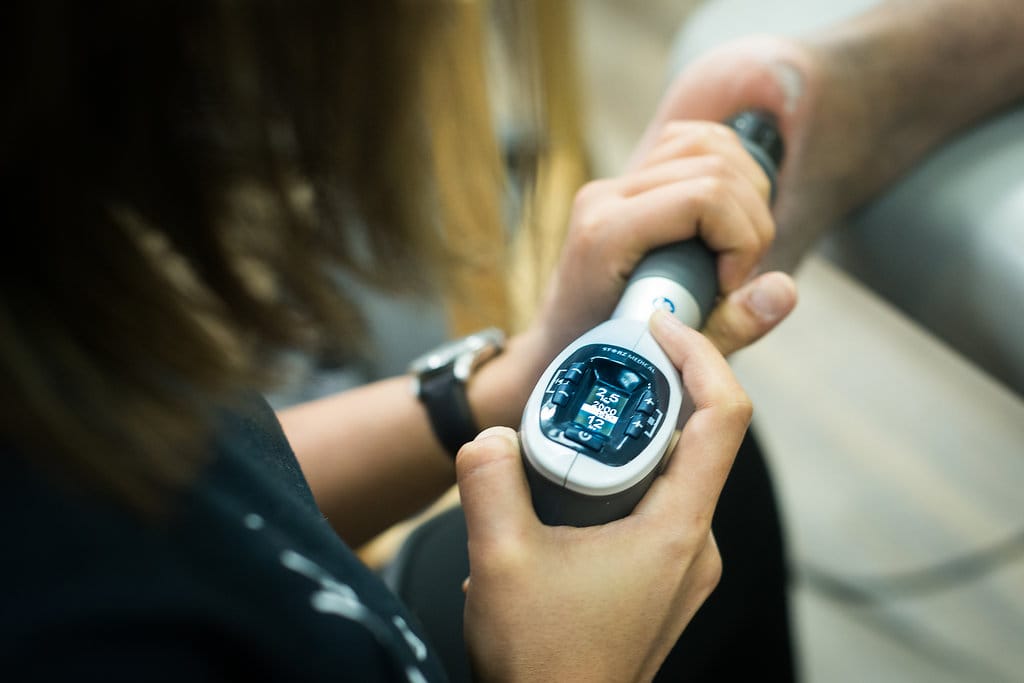
Here’s how shockwave therapy is typically used for plantar fasciitis:
- Mechanism of Action:
- Shockwave therapy works by delivering high-energy shockwaves to the affected area. These shockwaves create microtrauma in the tissue, which triggers the body’s natural healing response.
- The treatment is thought to stimulate blood flow, promote tissue regeneration, and reduce inflammation.
- Procedure:
- During the procedure, a gel is applied to the skin of the affected foot to help transmit the shockwaves.
- A handheld device is then used to deliver controlled shockwaves to the targeted area, typically the heel or the sole of the foot.
- Number of Sessions:
- The number of shockwave therapy sessions required can vary.
- Some individuals may experience relief after just one session, while others may require additional treatments.
- Post-Treatment:
- After the procedure, patients may experience temporary soreness or discomfort, but this usually subsides within a few days.
- It’s important to follow any post-treatment instructions provided by the healthcare provider, which may include rest, ice, and avoiding certain activities.
- Effectiveness: The use of shockwave therapy is often considered when conservative treatments, such as rest, stretching exercises, orthotics, and anti-inflammatory medications, have not provided sufficient relief.
It’s crucial to note that while shockwave therapy may be beneficial for some individuals, it may not be suitable for everyone. Patients should consult with their healthcare provider to determine the most appropriate treatment approach based on their specific condition and medical history.
Who can provide Shockwave Therapy at Triangle Physiotherapy?
Shockwave Therapy can be provided at our clinics by a physiotherapist, a chiropractor or a massage therapist.
Will Shockwave Therapy be covered by my insurance?
Yes, shockwave therapy will be covered depending on the healthcare practitioner providing the service. For example, if you are seeing a physiotherapist for shockwave therapy, it will be covered under your physiotherapy coverage.
How do I book an appointment with a physiotherapist or chiropractor near me?
Click HERE to book an appointment with a physiotherapist or chiropractor at one of our eight locations.
- Physiotherapy Etobicoke – Triangle Physiotherapy Etobicoke
- Oakville Physiotherapy Clinic – Triangle Physiotherapy Oakville
- Physiotherapy North York – Triangle Physiotherapy North York
- Mississauga Physiotherapy Clinics – Triangle Physiotherapy Mississauga
- Downtown Physiotherapy Clinics – Triangle Physiotherapy King West
- Uptown Physiotherapy Clinics – Triangle Physiotherapy Lawrence Park
- Physiotherapy Clinic Downtown Toronto – Triangle Physiotherapy Queens Quay
- Physiotherapy Clinics Mississauga – Triangle Physiotherapy Erin Mills
“Shockwave therapy is an effective treatment for plantar fasciitis, helping to reduce pain and promote healing. Triangle Physiotherapy provides expert care across the GTA, including Physiotherapy in Etobicoke, Oakville, North York, Toronto, Lawrence Park, Queens Quay, Erin Mills, Mississauga, and Liberty Village. Our skilled physiotherapists are here to help you find relief from plantar fasciitis and get back on your feet.”
